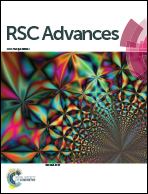Absorptive supramolecular elastomer wound dressing based on polydimethylsiloxane–(polyethylene glycol)–polydimethylsiloxane copolymer: preparation and characterization†
Abstract
Polydimethylsiloxanes (PDMS) are soft materials with high elasticity and excellent biocompatibility, giving them high potential for widespread applications as biomaterials. However, the application of PDMS to wound dressing is limited due to its shortcomings, particularly its non-absorptive and poor adhesive properties. This work addresses these limitations in two ways: first, a hydrophilic and biocompatible polyethylene glycol (PEG) block was introduced to the PDMS main chain to obtain carboxyl acid terminated PDMS-b-PEG-b-PDMS copolymers (EPMDS–COOH2); second, EPMDS–COOH2 polymers were reacted with diethylenetriamine and urea via a two-stage route to obtain a novel supramolecular elastomer (ESESi) based on multiple hydrogen bond association. Compared with the supramolecular elastomer based on simple PDMS (SESi), the hydrophilicity, water-absorption rate, adhesive ability and rate of water vapor permeation were significantly improved, enhancing the properties of ESESi films for application to wound dressing. After fully evaluating the bio-compatibilities of ESESi films, a full-thickness dermal wound model was chosen to estimate the healing performance, and traditional vaseline gauze, SESi film and commercialized Tegaderm™ film were chosen as controls. The results confirmed that the ESESi polymer could promote the healing of a skin wound to some extent, mainly due to its improved absorption and adhesive properties.


 Please wait while we load your content...
Please wait while we load your content...